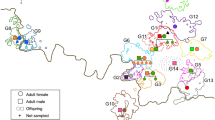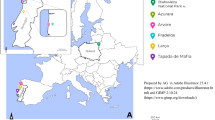Abstract
The determination of the degree of genetic relatedness among individuals is important for many population and behavioural studies1. Conventional genetic markers such as allozymes are usually inadequate for such determinations, especially in avian species2,3. Restriction fragment length polymorphisms (RFLPs) which are inherited as co-dominant mendelian alleles4, have recently been applied to paternity and maternity analyses in humans to address both medical diagnostic and legal5 issues. Field observations have led to the suggestion that lesser snow geese (Anser caerulescens caerulescens) engage in intraspecific brood parasitism (IBP)6 and extra-pair fertilization (EPF)7. Direct evidence for these suggestions has been difficult to obtain because of the lack of easily detectable genetic markers8. We have recently prepared a recombinant genomic library from the lesser snow goose and isolated seventeen probes that all identify RFLPs9. Here we use some of these polymorphic loci to examine the relatedness among members of four families. This study provides evidence for mixed maternity and paternity in broods of this socially monogamous species and demonstrates the utility of DNA markers for genetic analyses of species which traditionally exhibit few conventional genetic markers.
This is a preview of subscription content, access via your institution
Access options
Subscribe to this journal
Receive 51 print issues and online access
$199.00 per year
only $3.90 per issue
Buy this article
- Purchase on Springer Link
- Instant access to full article PDF
Prices may be subject to local taxes which are calculated during checkout
Similar content being viewed by others
References
Hamilton, W. D. J. theor. Biol. 7, 1–52 (1964).
Mumme, R. L., Koenig, W. D., Zink, R. M. & Marten, J. A. Auk 102, 305–312 (1985).
Barrowclough, G. F., Johnson, N. K. & Zink, R. M. Curr. Orn. 2, 135–154 (1986).
Botstein, D., White, R. L., Skolnick, M. & Davis, R. W. Am. J. hum. Genet. 32, 314–331 (1980).
Jeffreys, A. J., Brookfield, J. F. Y. & Semeonoff, R. Nature 317, 818–819 (1985).
Cooke, F. & Mirsky, P. J. Auk 89, 863–871 (1972).
Mineau, P. & Cooke, F. Behaviour 70, 280–291 (1979).
Bargiello, T. A., Grossfield, J., Steele, R. W. & Cooke, F. Biochem. Genet. 15, 741–763 (1977).
Quinn, T. W. & White, B. N. Molec. Biol. Evol. (in the press).
Cooke, F., MacInnes, C. D. & Prevett, J. P. Auk 92, 493–510 (1975).
Finney, G. H. thesis, Queen's Univ., Kingston (1975).
Author information
Authors and Affiliations
Rights and permissions
About this article
Cite this article
Quinn, T., Quinn, J., Cooke, F. et al. DNA marker analysis detects multiple maternity and paternity in single broods of the lesser snow goose. Nature 326, 392–394 (1987). https://doi.org/10.1038/326392a0
Received:
Accepted:
Issue Date:
DOI: https://doi.org/10.1038/326392a0
This article is cited by
Comments
By submitting a comment you agree to abide by our Terms and Community Guidelines. If you find something abusive or that does not comply with our terms or guidelines please flag it as inappropriate.



